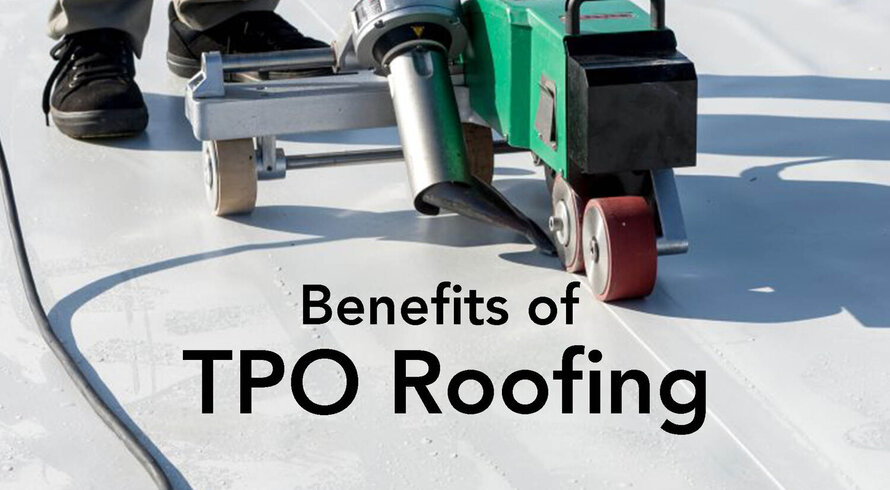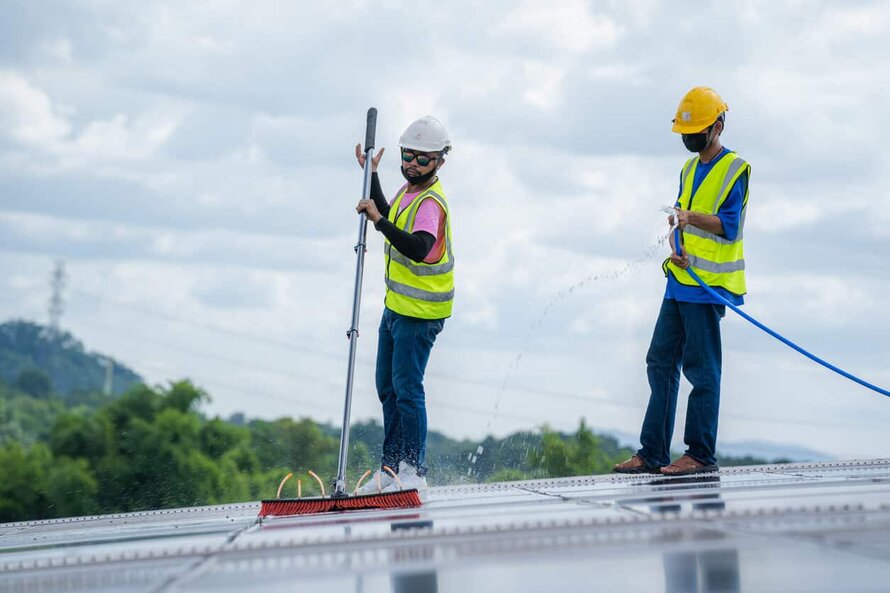In innovative areas of roof material, Thermoplastic Olefin (TPO) roofing has become popular for residential and commercial estates. It is renowned for many notable properties, providing a suitable choice for those seeking high-qualified roof solutions.
This article gives a deeper understanding of the composition and structure of TPO roofing, its outstanding advantages, and also basic maintenance tips to ensure that your TPO roof remains in optimal condition for the next few years.
1. Composition and structure of TPO roofing
What is TPO roofing? TPO (Thermoplastic Olefin) roof is a versatile material for roof covering. This solution is popular because of its ability not only to withstand harsh weather conditions but also to be energy and cost-effective.
The point of TPO roofing is the creative integration of components. TPO being a blend of polypropylene and ethylene-propylene rubber is a perfect material that merges the strength and properties of plastic with the rubber’s flexibility. That unique amalgamation brings TPO's mark of sturdiness and adjustability, making it the great choice for roofing applications.
A significant TPO roofing includes a blend of polypropylene, ethylene-propylene polymer, and polyester reinforcement. Its structure is aimed at durable and flexible improvement of the waterproofing membrane, making sure of long-lasting performance. For detail, these are the layers of a TPO membrane:
- The top is thermoplastic polyolefin: It protects against UV rays and the elements.
- The middle is a reinforced panel: This is usually made of polyester, giving strength and stability to the waterproof sheet.
- The bottom is thermoplastic polyolefin: That innermost layer with the view to ensure strong adhesion to the roof foundation.
They take advantage of those materials for each layer of TPO roofing, such as ethylene-propylene rubber for elasticity, carbon fiber to boost durability, glass fiber to raise stability, and talc to advance durability. These elements play an important role in the long life of the TPO roofing sheet.
2. Benefits of TPO roofing

What are the extraordinary gains of TPO roofing sheets?
TPO roofing is becoming well-liked for home and business real estate projects thanks to its numerous merits. You can see some top gains of TPO roofing below:
2.1. Cost-savings
TPO roofing sheet brings many of the same benefits as other materials like PVC but at a more reasonable price. Additionally, that roof covering being puncture, fire, and chemical resistant, reduces expenditure on upkeep and repair. The heat-welded joints of TPO roofing are especially strong, avoiding leaks and further helping to cut off maintenance expenses.
2.2. High durability and flexibility
That mixture combined with polypropylene and ethylene-propylene rubber is significantly durable and flexible. Because of this, TPO can adapt to different roof forms and withstand building movements without cracking. Therefore, TPO roofing, an extremely multifunctional roofing, is chosen for many commercial and domestic projects.
2.3. Good leak resistance
A remarkable attribute of TPO roofing is its possibility to protect against leaks. The joints of that sheet are hot air welded, providing a robust and watertight link. It is also convenient for repairing, as joints can easily be re-soldered if separate, guaranteeing long-term leak security.
2.4. Easy for installation
TPO roofing is lightweight wide panels. It is easily installed and is quicker than other roofing sheets, diminishes labor expenditures, and minimizes business disruption.
2.5. Energy-saving
TPO roofing is well-known for its excellent energy-saving advantage. This material can reflect heat, decreasing electricity bills because of lower demand for air conditioning. TPO sheets resist ultraviolet (UV) rays, ozone, and chemical exposure, assisting in maintaining cooler interior building temperatures. Therefore, TOP roofing is ideal for hot climates and those who want to advance their building's energy efficiency.
2.6. Environmentally friendly
As you can see, TPO roofing is eco-friendly because it does not contain chlorine or other harmful chemicals. Besides, TPO is 100% recyclable. Old TPO sheets can be recycled for new roofing materials, scaling down waste, and supporting sustainable building. Energy savings and recyclability make TPO a “green roof” option.
2.7. Visually appealing
TPO roofing sheets have a variety of colors, for example white, black, and grey. So, property owners can choose a color scheme that best suits the building's performance. This enhances the aesthetics of the TPO roofing and allows for greater design adaptability.
Read more: TPO Plastic: Everything you need to know
3. Maintenance tips you should know

Guides for TPO roofing care
Regular conservation is necessary for the longevity of TPO roofing. Inspecting and repairing help prolong the life of the roof system. This preservation is checking for leaks and flash, and the overall structure remains intact. See some tips to care effectively for the TPO roof:
3.1. Clean regularly
Clear and remove trash, debris, and dirt to keep the roof's ability to reflect light.
You can use a water blaster or a delicate-bristled brush to conduct.
3.2. Keep gutters cleaning
Clear debris in gutters to prevent water from pooling on the roof.
Regularly wash gutters seasonally for a year.
3.3. Cutting back surrounding tree limbs
You need to tidy tree boughs around the roof system. Cut plants that can be touched yourself. Hire a professional for other taller items.
3.4. Schedule annual check-up
Routine yearly checks are essential for long-term conservation. Thanks to this, you can find some problems with your TPO roofing such as ripping, thinning, and mold development early. The company providing inspection services will also examine the joints to see if these parts remain intact or damaged.
4. Conclusion
Overall, TPO roofing is a multifunctional and effective choice due to its many merits. That type of covering saves energy and cost and has impressive durability. The process of TPO sheet installation is relatively simple. Households and enterprises knowing its structure, and the best tips for preservation can make the right decisions for their roofing demands.
5. About EuroPlas
EuroPlas is a well-known global enterprise in the plastic area, specializing in first-rate and sustainable plastic approaches. We give priority to focus on advancement and sustainability. Therefore, we utilize top-notch technology, and a skilled workforce to provide customized plastic materials. Our solutions meet the diverse demands of industries in the world, not only in high standards, and trustworthiness but also in environmental duty.
Our highlight product range can be referred to as engineering plastic compounds, filler masterbatch, color masterbatch, plastic additives, bio filler, etc. EuroPlas promised to shape a more renewable future through excellent plastic products.
Visit our blog to keep updated on the most recent information about the plastic industry. Let contact us to learn more about our products, and learn how EuroPlas can support your business needs.